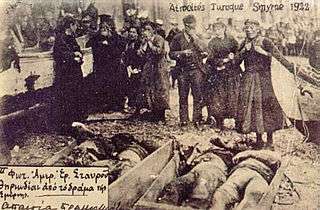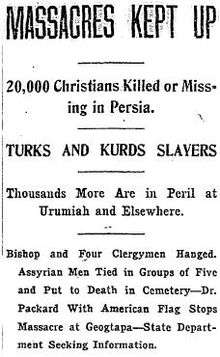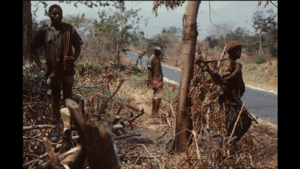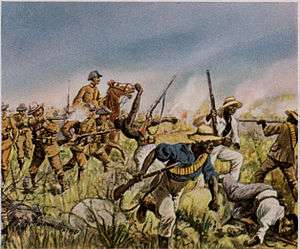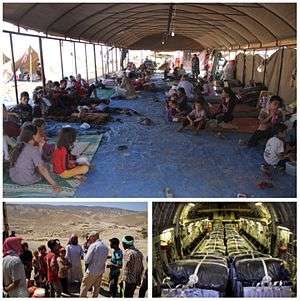List of genocides by death toll
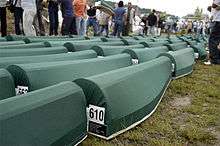
The below list of genocides by death toll includes death toll estimates of all deaths that are either directly or indirectly caused by genocide. It does not include non-genocidal mass killing such as the Thirty Years War, the Mongol Holocaust, the Japanese War Holocaust, the Blockade famine and other atrocities during the Nigerian Civil War, the Congolese Holocaust, the 1965 & 66 Indonesian Politicide or the Great Leap Forward.
The United Nations Convention on the Prevention and Punishment of the Crime of Genocide (CPPCG) defines genocide, in part, as "acts committed with intent to destroy, in whole or in part, a national, ethnical, racial or religious group".[1] Events listed have been characterized as genocide according to the United Nation's CPPCG. Various other definitions can be found in scholarly literature.
| Event | Location | Lowest estimate |
Highest estimate |
From | To | % |
|---|---|---|---|---|---|---|
The Holocaust, השואה (HaShoah, "the catastrophe")[N 1]
 |
Nazi-controlled Europe | 4,200,000 [4][5] |
6,200,000 [6] 11,000,000 [3] |
1939 | 1945 | 78% of Jews in Nazi-controlled Europe. 17% of Poland's total population. 13.7% of the Soviet Union's total population. |
Holodomor Голодомор, part of the Great Soviet Famine[N 2]
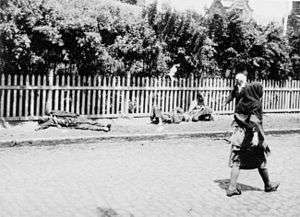 |
Ukrainian SSR and other republics of the Soviet Union | 1,800,000 [18][19][20][21] |
7,500,000 [22][23][24][25][26] |
1932 | 1933 | ≥10% of Ukraine's population[27] |
| Cambodian genocide (see also Khmer Rouge Killing Fields)[N 3]
|
Democratic Kampuchea | 1,700,000 [33][34][35][36] |
3,000,000 [35][37] |
1975 | 1979 | 21%-33% of Cambodia's population [38][39][36] |
Belarusian genocide (part of the greater Nazi Holocaust)[N 4]
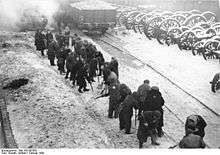 |
Soviet Belarus | 1,360,000 [40] |
1,970,000 [41] |
1941 | 1944 | 25.3% of Belarusian population |
| Soviet Ethnic Cleansings[N 5]
|
Soviet Union | 1,000,000 [44] |
1,500,000 [45] |
1920 | 1951 | 23.5% to 50% of total Chechen population[46][47][48][49][50] 30% of total Crimean Tatar population[51] |
Armenian genocide Մեծ Եղեռն (Medz Yeghern, "Great Crime")[N 6]
|
Ottoman Empire (territories of present-day Turkey, Syria and Iraq) |
800,000 [52] |
1,500,000 [53] |
1915 | 1922 | 75% of Armenians in Turkey |
| Rwandan genocide[N 7]
|
Rwanda | 500,000 [54] |
1,000,000 [54] |
1994 | 1994 | 70% of Tutsis in Rwanda 1/3 of Rwandan Pygmies 20% of Rwanda's total population |
| Genocide of Cathars during the Crusades[N 8]
|
Languedoc, France | 200,000 [60] |
1,000,000 [64] |
1209 | 1229 | |
Greek genocide including the Pontic genocide[N 9]
|
Ottoman Empire (territories of present-day Turkey) |
289,000 [65] |
750,000 [66] |
1914 | 1922 | 13 to 30% of Greeks in Anatolia[67] |
Assyrian genocide ܣܝܦܐ (Seyfo, "Sword")[N 10]
|
Ottoman Empire (territories of present-day Turkey, Syria and Iraq) |
275,000 [68] |
750,000 [68] |
1915 | 1923 | 75% of Assyrian population in Turkey[69] |
| Zunghar genocide 准噶尔灭族 in the Zunghar Khanate[N 11]
|
Western Mongolia, Kazakhstan, northern Kyrgyzstan, southern Siberia | 480,000 [73] |
600,000 [73] |
1755 | 1758 | 80% of 600,000 Zungharian Oirats |
| Porajmos (Romani genocide)[N 12]
|
Nazi controlled Europe | 130,000 [82] |
500,000 [83][84] |
1935 | 1945 | 25% of Romani people in Europe |
| Ustaše genocides of Jews, Roma, Serbs, and others[N 13]
|
Independent State of Croatia | 357,000 [86][87] |
385,000 [86][87][88] |
1941 | 1945 | Almost 17% of Serbians in the Independent State of Croatia [89] |
| East Timorese genocide[N 14]
|
Timor Leste | 85,320 [92][93][94][95] |
196,720 [92][93][94][96] |
1975 | 1999 | 10 to 23% of East Timor's population[92][93][94][97] |
| Burundian genocides of Hutus and Tutsis[N 15]
|
Burundi | 80,000 [98][99] 50,000 [100] |
210,000 [98][99] 50,000 [100] |
1972 1993 |
1972 1993 |
|
| Ba'athist genocide against Kurdish peoples[N 16]
|
Ba'athist Iraq | 50,000 [103] |
200,000 [104][102][105] |
1986 | 1989 | |
| Guatemalan genocide[N 17]
|
Guatemala | 35,000 [110] |
170,000 [111] |
1962 | 1996 | |
| Herero and Namaqua genocide[N 18]
|
German South-West Africa | 34,000 [112] |
110,000 [113][114] |
1904 | 1908 | |
| Bosnian genocide[N 19]
|
Bosnia and Herzegovina | 8,373 [119] |
25,609 39,199 [120] |
1992 | 1995 | Bosnian War killed 3.1% of Bosniak population in Bosnia and Herzegovina Bosnian War killed 1.4% of Serb population in Bosnia and Herzegovina Bosnian War killed 1% of Croat population in Bosnia and Herzegovina Bosnian War killed 2% of total population of Bosnia and Herzegovina [121] |
| Selk'nam genocide[N 20]
|
Chile, Tierra del Fuego | 2,500 [122] |
3,900 [123] |
Late 19th Century | Early 20th Century | 84% to almost 100% Now pure Selk'nam are considered extinct.[123][124] |
| Bengali Genocide in Eastern Pakistan[N 21]
|
Bangladesh | Estimates for the Bangaladeshi Genocide are vastly different from each other and there is no general consensus of the range, so to avoid controversy all major estimates will be listed: 26,000 [126] 50,000 [127]
|
3,000,000 [137][138] |
1971 | 1971 | 4% of "East Pakistan's" total population [139] |
| ISIL's Genocides of Yazidis, Christians, and Shias[N 22]
|
northern Iraq and Syria | thousands[151] | 2014 | present |
Non-Genocidal Mass Killings
| Non-Genocidal Mass Killings | |
|---|---|
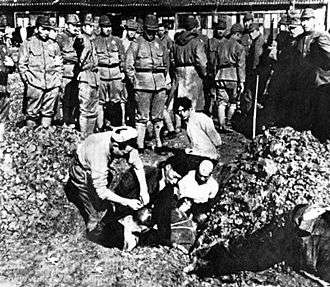 | |
| Deaths |
Mongol Holocaust during conquest 40 to 70 million killed[152][153][154][155]
|
This list excluded events that do not meet the legal definition of genocide, some scholars broadly define genocide as "premeditated mass killing of civilians" and by that metric there are many events in history that meet this definition not listed here that match or even far exceed the scale of those listed here. For a list of such events go here. -->
See also
Notes
- ↑ The Holocaust was the systematic, bureaucratic, state-organized, persecution and murder of approximately 6 million Jews by the German Nazi government and its collaborators. Initially it was carried out in German-occupied Eastern Europe by paramilitary death squads (Einsatzgruppen) by shooting or, less frequently, by using ad hoc built gassing vans, and later in extermination camps by gassing.[2] The plan to exterminate the European Jewry (the Final solution to the Jewish question) was the founding element of the Holocaust. Nevertheless many other groups of the civilian population were swallowed by the genocidal frenzy of the Nazi state.[3]
- ↑ In 2003 Holodomor, the man-made famine in Ukraine, was recognized by the United Nations as the result of cruel actions and policies of the Soviet government of Joseph Stalin that caused millions of deaths,[7] and in 2008 by the European Parliament as a crime against the Ukrainian people, and against humanity.[8] Holodomor is considered a genocide in Ukraine,[9], Australia,[10] Canada,[11] Colombia,[12] Ecuador,[13] Estonia,[14] Georgia,[14] Hungary,[14] Latvia,[14] Lithuania,[14] Mexico,[14] Paraguay,[14] Peru,[14] Poland,[15] and Vatican City,[14] while the Russian Federation views it as part of the wider Soviet famine of 1932-33.[16] Scholars are divided and their debate is inconclusive on whether the Holodomor falls under the definition of genocide.[17]
- ↑ The Cambodian genocide was carried out by the Khmer Rouge led by Pol Pot[28] who, planning to create a form of agrarian socialism founded on an extremist ideology coupled with ethnic hostility, forced the urban population to relocate savagely to the countryside, among torture, mass executions, forced labor, and starvation. The genocide ended in 1979 with the Cambodian invasion by the Vietnamese army.[29] Up to 20,000 mass graves, the infamous Killing Fields, were uncovered,[30] where at least 1,386,734 murdered victims found their final resting place.[31] On 7 August 2014, two top leaders, Nuon Chea and Khieu Samphan, received life sentences for crimes against humanity.[32]
- ↑ The Belarusian Genocide is the portion of The Holocaust that occurred in Nazi occupied Soviet Belarus during World War II. It affected the civilian population, of Jewish as well as Belarusian ethnicity, with massacres, genocide by bullet and scorched earth operations that burned to the ground innumerable villages and towns. Belarus suffered the most among the nations occupied by Nazi Germany, with a death toll of over 25% of its' population, even more than Poland (17%).
- ↑ Some of the violent Ethnic cleansing campaigns of Soviet Union have been recognized as genocide. The Deportation of the Crimean Tatars is recognized as genocide by Ukraine[42] and the Deportation of Chechens is recognized as genocide by the European Parliament.[43]
- ↑ The extermination of the Armenians, carried out by the Young Turks, led to the coining of the word "genocide". It included massacres, forced deportations involving death marches, mass starvation, and occurred concurrently with the Assyrian and Greek genocides. The State of Turkey denies a genocide ever occurred.
- ↑ Some 50 perpetrators of the Ruandan genocide have been found guilty by the International Criminal Tribunal for Rwanda, but most others have not been charged due to lack of witness accounts. Another 120,000 were arrested by Rwanda; of these, 60,000 were tried and convicted in the Gacaca court system. Perpetrators who fled into Zaire (Democratic Republic of the Congo) were used as a justification when Rwanda and Uganda invaded Zaire (First and Second Congo Wars). It is recognized by the international community as a genocide.
- ↑ Raphael Lemkin, who coined the term genocide, referred to the Albigensian Crusade a 20-year military campaign initiated by Pope Innocent III to eliminate Catharism in Languedoc (the south of France) as "one of the most conclusive cases of genocide in religious history" and many other historians share the sentiment that the events of the crusade constitute genocide.[55][56][57][58][59][60] However some disagree with this characterization.[61][62][63]
- ↑ For the Greek genocide other sources give 450,000-900,000 casualties between Pontic, Cappadocian and Ionians Greeks. The genocide, instigated by the Ottoman government, included massacres, forced deportations involving death marches, summary expulsions, arbitrary executions, and destruction of Greek Orthodox cultural, historical and religious monuments.
- ↑ The Assyrian genocide is commonly known as "Seyfo" (which means sword in Assyrian). It occurred concurrently with the Armenian and Greek genocides.
- ↑ Zunghar genocide. The Manchu Qianlong Emperor of Qing China issued his orders for his Manchu Bannermen to carry out the genocide and eradication of the Zunghar nation, ordering the massacre of all the Zunghar men and enslaving Zunghar women and children.[70] The Qianlong Emperor moved the remaining Zunghar people to the mainland and ordered the generals to kill all the men in Barkol or Suzhou, and divided their wives and children to Qing soldiers.[71][72] The Qing soldiers who massacred the Zunghars were Manchu Bannermen and Khalkha Mongols. In an account of the war, Wei Yuan wrote that about 40% of the Zunghar households were killed by smallpox, 20% fled to Russia or the Kazakh Khanate, and 30% were killed by the army, leaving no yurts in an area of several thousands of Chinese miles except those of the surrendered.[73][74][75] Clarke wrote 80%, or between 480,000 and 600,000 people, were killed between 1755 and 1758 in what "amounted to the complete destruction of not only the Zunghar state but of the Zunghars as a people."[73][76] Historian Peter Perdue has shown that the decimation of the Dzungars was the result of an explicit policy of extermination launched by the Qianlong Emperor.[73] Although this "deliberate use of massacre" has been largely ignored by modern scholars,[73] Mark Levene, a historian whose recent research interests focus on genocide, has stated that the extermination of the Dzungars was "arguably the eighteenth century genocide par excellence".[77]
- ↑ Porajmos (Romani pronunciation: IPA: [pʰoɽajˈmos]), or Samudaripen ("Mass killing"), the Romani genocide or Romani Holocaust, was the planned and attempted effort by the government of Nazi Germany and its allies to exterminate the Romani people of Europe. On 26 November 1935 a supplementary decree to the Nuremberg Laws defined the Gypsies as "enemies of the race-based state", the same category as the Jews.[78] Thus, in some way they endured the same fate.[79] In 1982, West Germany formally recognized that genocide had been committed against the Romani.[80] In 2011 the Polish Government passed a resolution for the official recognition of the 2nd of August as a day of commemoration of the genocide.[81]
- ↑ Genocide by the Ustaše. The government of the Independent State of Croatia murdered Serbs, Jews, Romani and antifascist Croats and Bosnian Muslims inside its borders, many in concentration camps, like the infamous Jasenovac camp. Ante Pavelić, the leader of the Ustaše, enacted racial laws similar to those of Nazi Germany, declaring Jews, Romani and Serbs "enemies of the people of Croatia".[85]
- ↑ A academic consensus holds that the Indonesian occupation of East Timor amounted to genocide.[90] For twenty-four years the Indonesian government subjected the people of East Timor to extrajudicial executions, routine and systematic torture, massacres and deliberate starvation.[91]
- ↑ Burundian genocide. In the long sequence of civil fights that occurred between Tutsi and Hutu since Burundi's independence in 1962, the 1972 mass killings of Hutu by the Tutsi and the 1993 mass killings of Tutsis by the majority-Hutu populace are both described as genocide in the final report of the International Commission of Inquiry for Burundi presented to the United Nations Security Council in 1996.
- ↑ The Kurdish genocide also known as al-Anfal campaign (Arabic: حملة الأنفال), [101] was a series of genocidal operations[102] against the Kurdish people and other non-Arab populations in northern Iraq, that was led by the Ba'athist Iraqi President Saddam Hussein and was headed by Ali Hassan al-Majid in the final stages of the Iran–Iraq War. The code name chosen by the former Iraqi Baathist government for this campaign takes its name from Surat al-Anfal, the eighth chapter of the Quran. The Anfal operations also targeted Assyrians, Shabaks, Iraqi Turkmens, Yazidis, Jews, Mandaeans, and many villages belonging to these ethnic groups were also destroyed. The Anfal campaign was recognized as a genocide by Norway, Sweden, the United Kingdom, and South Korea.
- ↑ Guatemalan genocide. The government forces of Guatemala and allied paramilitary groups have been condemned by the Historical Clarification Commission for committing genocide against the Maya population[106][107] and for widespread human rights violations against civilians during the civil war fought against various leftist rebel groups. At least an estimated 200,000 persons lost their lives by arbitrary executions, forced disappearances and other human rights violations.[108] A quarter of the direct victims of human rights violations and acts of violence were women.[109]
- ↑ The Herero and Namaqua Genocide was the campaign to exterminate the Herero and Nama people that the German Empire undertook in German South-West Africa (modern-day Namibia). It is considered one of the first genocides of the 20th century.
- ↑ The Bosnian genocide comprises localized, in time and place, massacres like in Srebrenica[115] and in Žepa committed by Bosnian Serb forces in 1995, as well as the scattered ethnic cleansing campaign throughout areas controlled by the Army of Republika Srpska[116] that took place during the 1992–1995 Bosnian War.[117] The Srebrenica massacre is the most recent act of genocide committed in Europe and is the only event of the war that fulfills the definition of genocide set by the International Criminal Tribunal for the former Yugoslavia. On 31 March 2010 the Serbian Parliament passed a resolution condemning the Srebrenica massacre and apologizing to the families of Srebrenica for the deaths of Bosniaks.[118]
- ↑ The Selk'nam Genocide was the genocide of the Selk'nam people, indigenous inhabitants of Tierra del Fuego in South America, from the second half of the 19th to the early 20th century. Spanning a period of between ten and fifteen years the Selk'nam, which had an estimated population of some three thousand, saw their numbers reduced to 500.[122]
- ↑ Bangladesh genocide. Massacres, killings, rape, arson and systematic elimination of religious minorities (particularly Hindus), political dissidents and the members of the liberation forces of Bangladesh were conducted by the Pakistan Army with support from paramilitary militias—the Razakars, Al-Badr and Al-Shams—formed by the radical Islamist Jamaat-e-Islami party.[125]
- ↑ The Genocide of Yazidis, Christians, and Shias ' by ISIS includes mass killing, rape and enslavement of girls and women, forced abduction, indoctrination and recruitment of Yazidis boys (aged 7 to 15) to be used in armed conflicts, forced conversion to Islam and expulsion from their ancestral land. The United Nations' Commission of Inquiry on Syria officially declared in its report that ISIS is committing genocide against the Yazidis population.[140] It is difficult to assess a precise figure for the killings[141] but it is known that some thousand of Yazidis men and boys are still unaccounted for and ISIS genocidal actions against Yazidis people are still ongoing, as stated by the International Commission in June 2016. The European Union, the British Parliament, and the United States unanimously recognize the treatment of Christian minorities under ISIL's control as genocide.[142][143][144][145][146][147][148] John Kerry called the treatment of Shias by ISIL genocide.[149][150]
References
- ↑ "Analysis Framework" (PDF). Office Of The Un Special Adviser On The Prevention Of Genocide (OSAPG).
- ↑ For a listing of the number of murdered Jews, detailed by country, see Dawidowicz, Lucy (2010). The War Against the Jews: 1933-1945. Open Road Media. Appendix A. ISBN 978-1453203064.
- 1 2 3 4 By extending the definition of the Holocaust to include other victims of Nazi crimes against humanity and war crimes, such as the Romani genocide, Germany's eugenics program, and the murder of Soviet POWs, Poles and other Slavic populations, political opponents, Homosexuals, Jehovah's Witnesses, and civil hostages and resisters from all over Europe.
- ↑ Reitlinger, Gerald (1953). The Final Solution. The Attempt to Exterminate the Jews of Europe, 1939–1945. New York City: Beechhurst Press. Reviewed by Friedman, Philip (1954). "Review of The Final Solution". Jewish Social Studies. 16 (2): 186–9. JSTOR 4465231. See also Hyamson, Albert M. (1953). "Review of The Final Solution". International Affairs. 29 (4): 494–5. JSTOR 2606046.
- ↑ Early efforts by scholars to determine the number of Jews murdered by the Nazis were limited by a lack of access to pertinent records. The genocide seldom entered Western discourse, both due to ignorance and to the Cold-War politics which made West Germany a new ally of the United States.The first significant work on the subject published in English was Gerald Reitlinger's Final Solution (1953), which, relying almost exclusively on German documentation, estimated 4.9 million dead. This figure is now considered extremely conservative. Raul Hilberg's 1961 The Destruction of the European Jews, a classic in the field of Holocaust literature, estimates its victims to be 5.1 million lives, or 4.9 - 5.4 million broadly construed. The trial of Adolph Eichmann also provided documentation and testimony which revised the number of the dead.The first work to arrive at a figure comparable to modern estimates was Lucy Dawidowicz's The War Against the Jews, published in 1975, which provided detailed listings by country of the number of Jews killed in the Holocaust. It is still used as a reference in modern Holocaust studies. Dawidowicz researched birth and death records in many cities of prewar Europe to come up with 5,933,900 murdered Jews. After the opening of Soviet records, scholarship arrived at a death toll of about 6 million Jews. Gutman and Rozett's Encyclopedia of the Holocaust, published in 1990, gives a figure of slightly over 5.9 million Jews killed. Wolfgang Benz's The Holocaust: A German Historian Examines the Genocide, published in 1995, gives a toll of 6.2 million.
- ↑ Benz, Wolfgang (1999). The Holocaust: A German Historian Examines the Genocide. New York: Columbia University Press. pp. 152–3. ISBN 0-231-11214-9.
- ↑
 Works related to Joint Statement on Holodomor at Wikisource.
Works related to Joint Statement on Holodomor at Wikisource. - ↑ European Parliament resolution on the commemoration of the Holodomor, the Ukraine artificial famine (1932–1933)
- ↑ "The Artificial Famine/Genocide (Holodomor) in Ukraine 1932-33". InfoUkes. 26 April 2009.
- ↑ "Historical Events—Holodomor—80th Anniversary(No. 18)". Senate Journal. 6: 232. 4 December 2013.
- ↑ "Journals of the Senate No.72, 2nd Session, 37th Parliament" (PDF). 19 June 2003: 994–5. Retrieved 24 July 2016.
- ↑ "Columbia declares Holodomor an act of genocide". Ukrainian Helsinki Human Rights Union. 25 December 2007. Archived from the original on 19 February 2009. Retrieved 26 March 2008.
- ↑ "Aprueba resolución: Congreso se solidariza con pueblo Ucraniano" [Resolution passed: Congress is in solidarity with Ukrainian people]. National Congress of Ecuador (in Spanish). 30 October 2007. Archived from the original on 2 November 2007. Retrieved 31 October 2007.
- 1 2 3 4 5 6 7 8 9 "International Recognition of the Holodomor". Holodomoreducation.org. 28 November 2006. Retrieved 24 July 2016.
- ↑ "Sprawozdanie - Komisji Ustawodawczej oraz Komisji Spraw Zagranicznych - o projekcie uchwały w sprawie rocznicy Wielkiego Głodu na Ukrainie" [Report of the Legislative Committee and Foreign Affairs Committee on the project resolution concerning the anniversary of the Great Famine in Ukraine] (PDF) (in Polish). Senate of the Republic of Poland. 14 March 2006. Retrieved 24 July 2016.
- ↑ "Russian lawmakers reject Ukraine's view on Stalin-era famine". Sputnik International. RIA Novosti. 2 April 2008.
- ↑ David Marples (30 November 2005). "The great famine debate goes on...". ExpressNews. Archived from the original on 15 June 2008.
- ↑ Wheatcroft, Stephen G. (2001). "Current knowledge of the level and nature of mortality in the Ukrainian famine of 1931–3" (PDF). In V. Vasil'ev; Y. Shapovala. Komandiri velikogo golodu: Poizdki V.Molotova I L.Kaganovicha v Ukrainu ta na Pivnichnii Kavkaz, 1932–1933 rr. Kyiv: Geneza.
- ↑ Vallin, Jacques; France Meslé; Serguei Adamets; Serhii Pyrozhkov (2002). "A new estimate of Ukrainian population losses during the crises of the 1930s and 1940s" (PDF). Population Studies. 56 (3): 249–264. doi:10.1080/00324720215934. ISSN 0032-4728. PMID 12553326. Retrieved 13 August 2016.
- ↑ Meslé, France; Gilles Pison; Jacques Vallin (May 2005). "France-Ukraine: Demographic Twins Separated by History" (PDF). Population and Societies. Institut national d’études démographiques (413): 1–4. Archived from the original (PDF) on 21 November 2006.
- ↑ Meslé, France; Vallin, Jacques (2003). Mortalité et causes de décès en Ukraine au XXème siècle (in French). Contributions by Vladimir Shkolnikov, Serhii Pyrozhkov, Serguei Adamets. Institut National d'Études Démographiques (INED). ISBN 978-2733201527.
- ↑ Rosefielde, Steven (1983). "Excess Mortality in the Soviet Union: A Reconsideration of the Demographic Consequences of Forced Industrialization, 1929–1949". Soviet Studies. 35 (3): 385–409. doi:10.1080/09668138308411488. JSTOR 151363.
- ↑ Наливайченко назвал количество жертв голодомора в Украине [Nalyvaichenko called the number of victims of Holodomor in Ukraine] (in Russian). LB.ua. 14 January 2010. Retrieved 21 July 2012.
- ↑ Snyder, Timothy (2010). Bloodlands: Europe Between Hitler and Stalin. London: The Bodley Head. p. 53. ISBN 978-0224081412.
One demographic retrojection suggests a figure of 2.5 million famine deaths for Soviet Ukraine. This is too close to the recorded figure of excess deaths, which is about 2.4 million. The latter figure must be substantially low, since many deaths were not recorded. Another demographic calculation, carried out on behalf of the authorities of independent Ukraine, provides the figure of 3.9 million dead. The truth is probably in between these numbers, where most of the estimates of respectable scholars can be found. It seems reasonable to propose a figure of approximately 3.3 million deaths by starvation and hunger-related disease in Soviet Ukraine in 1932–1933.
- ↑ Marples, David R. (2007). Heroes and Villains: Creating National History in Contemporary Ukraine. Central European University Press. p. 50. ISBN 978-963-7326-98-1. Retrieved 13 August 2016.
- ↑ "Ukraine - The famine of 1932–33". Encyclopædia Britannica.
The Great Famine (Holodomor) of 1932–33—a man-made demographic catastrophe unprecedented in peacetime. Of the estimated six to eight million people who died in the Soviet Union, about four to five million were Ukrainians. ... Its deliberate nature is underscored by the fact that no physical basis for famine existed in Ukraine. ... Soviet authorities set requisition quotas for Ukraine at an impossibly high level. Brigades of special agents were dispatched to Ukraine to assist in procurement, and homes were routinely searched and foodstuffs confiscated... The rural population was left with insufficient food to feed itself.
- ↑ Paul R. Bartrop, Steven Leonard Jacobs (2014). Modern Genocide: The Definitive Resource and Document Collection [4 volumes]: The Definitive Resource and Document Collection. ABC-CLIO. p. 2064. ISBN 9781610693646.
- ↑ Frey, Rebecca Joyce (2009). Genocide and International Justice. Facts On File. p. 83. ISBN 978-0816073108.
- ↑ Mayersan, Deborah (2013). ""Never Again" or Again and Again". In Mayersen, Deborah; Pohlman, Annie. Genocide and Mass Atrocities in Asia: Legacies and Prevention. Routledge. p. 182. ISBN 978-0415645119.
- ↑ DeMello, Margo (2013). Body Studies: An Introduction. Routledge. p. 86. ISBN 978-0415699303.
- ↑ Documentation Center of Cambodia - Mapping of mass graves.
- ↑ McKirdy, Euan (8 August 2014). "Top Khmer Rouge leaders found guilty of crimes against humanity, sentenced to life in prison". CNN. Archived from the original on 28 September 2015. Retrieved 10 August 2014.
- ↑ The CGP, 1994–2008 Cambodian Genocide Program, Yale University.
- ↑ Terry, Fiona (2002). Condemned to Repeat?: The Paradox of Humanitarian Action. Cornell University Press. p. 116. ISBN 978-0801487965.
- 1 2 Heuveline, Patrick (2001). "The Demographic Analysis of Mortality in Cambodia". In Reed, Holly E.; Keely, Charles B. Forced Migration and Mortality. Washington, DC: National Academy Press.
- 1 2 White, Matthew. "20th Century death tolls larger than one million but fewer than 5 million people - Cambodia". Necrometrics:
- Vietnamese ethnicity: 10,000 (100%)
- Chinese ethnicity: 215,000 (50%)
- Laos ethnicity: 4,000 (40%)
- Thai ethnicity: 8,000 (40%)
- Cham ethnicity: 90,000 (36%)
- Urban Khmer: 500,000 (25%)
- Rural Khmer: 825,000 (16%)
- ↑ The Quality of Mercy: Cambodia, Holocaust, and Modern Conscience. Touchstone. 1985. p. 115–6.
- ↑ Etcheson, Craig (2005). After the Killing Fields: Lessons from the Cambodian Genocide. Greenwood. p. 119. ISBN 978-0275985134.
- ↑ Heuveline, Patrick (1998). "'Between One and Three Million': Towards the Demographic Reconstruction of a Decade of Cambodian History (1970-79)". Population Studies. Taylor & Francis. 52 (1): 49–65. doi:10.1080/0032472031000150176. JSTOR 2584763.
- ↑ All civilians killed by Crimes Against Humanity
- ↑ All civilians killed in Belarus
- ↑ "Ukraine's Parliament Recognizes 1944 'Genocide' Of Crimean Tatars". RadioFreeEurope/RadioLiberty.
- ↑ UNPO: Chechnya: European Parliament recognizes the genocide of the Chechen People in 1944
- ↑ Naimark, Norman M. Stalin's Genocides (Human Rights and Crimes against Humanity). Princeton University Press, 2010. p. 131. ISBN 0-691-14784-1
- ↑ Rosefielde, Steven (2009). Red Holocaust. Routledge. p. 84. ISBN 978-0-415-77757-5.
- ↑ Wood, Tony. Chechnya: the Case for Independence. page 37-38
- ↑ Nekrich, Punished Peoples
- ↑ Dunlop. Russia Confronts Chechnya, pp 62-70
- ↑ Gammer. Lone Wolf and the Bear, pp166-171
- ↑ Soviet Transit, Camp, and Deportation Death Rates
- ↑ Williams, Brian Glyn (2001). The Crimean Tatars: The Diaspora Experience and the Forging of a Nation. BRILL. p. 401. ISBN 9789004121225.
- ↑ John G. Heidenrich (2001). How to prevent genocide: a guide for policymakers, scholars, and the concerned citizen. Greenwood Publishing Group. p. 5. ISBN 978-0-275-96987-5.
- ↑ Adalian, Rouben Paul (2004). "Armenian Genocide". Washington, DC: Armenian National Institute. Retrieved 13 August 2016.
- 1 2 See, e.g., Rwanda: How the genocide happened, BBC, April 1, 2004, which gives an estimate of 800,000, and OAU sets inquiry into Rwanda genocide, Africa Recovery, Vol. 12 1#1 (August 1998), page 4, which estimates the number at between 500,000 and 1,000,000. 7 out of 10 Tutsis were killed.
- ↑ Raphael Lemkin (2012). Steven Leonard Jacobs, ed. Lemkin on Genocide. Lexington Books. p. 71. ISBN 978-0-7391-4526-5. Retrieved 14 February 2016.
- ↑ Mark Gregory Pegg (2008). A Most Holy War: The Albigensian Crusade and the Battle for Christendom. Oxford University Press. p. 195. ISBN 978-019988371-4.
- ↑ Marvin, Laurence W. (October 2009). "A Most Holy War: The Albigensian Crusade and the Battle for Christendom (review).". The Catholic Historical Review. 95 (4): 801–802. doi:10.1353/cat.0.0546.
- ↑ Kurt Jonassohn; Karin Solveig Björnson. Genocide and Gross Human Rights Violations: In Comparative Perspective. Transaction Publishers. p. 50. ISBN 978-1-4128-2445-3.
The Albigensian Crusade was the first ideological genocide and it is included here because it gave rise to the Inquistion–an instutiton which developed many of the techniques of persecution that are still in wide use today.
- ↑ Frank Robert Chalk; Kurt Jonassohn; Institut montréalais des études sur le génocide (1990). The History and Sociology of Genocide: Analyses and Case Studies. Yale University Press. pp. 114–138. ISBN 978-0-300-04446-1.
- 1 2 Colin Martin Tatz; Winton Higgins (31 March 2016). The Magnitude of Genocide. ABC-CLIO. p. 214. ISBN 978-1-4408-3161-4.
The papacy and the French king rounded out the Crusaders' genocidal achievements with their thirteenth-century Albigensian crusade against the Cathars in southern France—a rampage that resulted in some 200,000 more victims, and constituted yet another "completed" genocide.
- ↑ Christopher Tyerman, God's War: A New History of the Crusades Belknap Press (February 28, 2009) p. 604
- ↑ http://bedejournal.blogspot.com/2011/11/pinker-tackles-albigensian-crusade.html
- ↑ Lerner, Robert E. (2010). (review). "A Most Holy War: The Albigensian Crusade and the Battle for Christendom". Common Knowledge. 16 (2): 292. doi:10.1215/0961754X-2009-101.
- ↑ http://necrometrics.com/pre1700a.htm#Albigensian (Accumulated by Matthew White
- John M. Robertson, A Short History of Christianity, London: Watts, 1902, p.254 ("It has been reckoned that a million of all ages and both sexes were slain.")
- Christopher Brookmyre, Not the End of the World (New York: Grove Press, 1998) p.39
- Max Dimont, Jews, God, and History, (New York: Penguin, 1994) p.225: 1,000,000 Frenchmen suspected of being Albigensians slain
- Dizerega Gus, Pagans & Christians: The Personal Spiritual Experience (St. Paul, MN: Llewellyn, 2001) p.195
- Helen Ellerbe, The Dark Side of Christian History (Orlando, FL: Morningstar & Lark, 1995) p.74
- Michael Newton, Holy Homicide (Port Townsend, WA: Loompanics Unlimited, 1998) p.117
- ↑ Rummel, Rudolph J. (1997). "Statistics Of Turkey's Democide. Estimates, Calculations, and Sources". Statistics of Democide: Genocide and Mass Murder Since 1900. Charlottesville, VA: University of Virginia and Transaction Publishers, Rutgers University. Retrieved 15 April 2015. Table 5.1B.
- ↑ Jones, Adam (2010). Genocide: A Comprehensive Introduction (2nd ed.). Routledge. pp. 150–1. ISBN 0-415-48619-X.
- ↑ 289 to 750 thousand killed out of a population of 2.5 million Benvenuto, Jeff. "The Genocide of Ottoman Greeks, 1914-1923". Rutgers Newark College of Arts and Sciences University College.
- 1 2 Assyrian Genocide; Lexicorient
- ↑ Benvenuto, Jeff. "The Assyrian Genocide, 1914 to 1923 and 1933 up to the present". Rutgers Newark College of Arts and Sciences.
- ↑ Millward, James A. (2007). Eurasian Crossroads: A History of Xinjiang. Columbia University Press. p. 95. ISBN 978-0-231-13924-3. Retrieved 13 August 2016.
- ↑ 大清高宗純皇帝實錄, 乾隆二十四年
- ↑ 平定準噶爾方略
- 1 2 3 4 5 6 Perdue, Peter C. (2005). China Marches West: The Qing Conquest of Central Eurasia. Harvard University Press. ISBN 978-0674016842.
- ↑ Wei Yuan, 聖武記 Military history of the Qing Dynasty, vol.4. "計數十萬戶中,先痘死者十之四,繼竄入俄羅斯哈薩克者十之二,卒殲於大兵者十之三。除婦孺充賞外,至今惟來降受屯之厄鲁特若干戶,編設佐領昂吉,此外數千里間,無瓦剌一氊帳。"
- ↑ Lattimore, Owen (1950). Pivot of Asia; Sinkiang and the inner Asian frontiers of China and Russia. Little, Brown. p. 126.
- ↑ Clarke, Michael Edmund (2004). In the Eye of Power (PDF) (doctoral thesis). Brisbane: Griffith University. p. 37. Archived from the original (PDF) on 29 February 2012.
- ↑ Moses, A. Dirk (2008). Empire, Colony, Genocide: Conquest, Occupation, and Subaltern Resistance in World History. Berghahn Books. ISBN 978-1845454524.
- ↑ Milton, Sybil (February 1992). "Nazi Policies towards Roma and Sinti 1933-1945". Journal of Gypsy Lore Society. 5. 2 (1): 1–18. Retrieved 12 August 2016.
- ↑ "Holocaust Encyclopedia - Genocide of European Roma (Gypsies), 1939-1945". United States Holocaust Memorial Museum (USHMM). Retrieved 9 August 2011.
- ↑ "Holocaust Memorial Day: 'Forgotten Holocaust' of Roma finally acknowledged in Germany". The Telegraph. 27 January 2011. Retrieved 8 March 2015.
- ↑ "OSCE human rights chief welcomes declaration of official Roma genocide remembrance day in Poland". OSCE. 29 July 2011. Retrieved 12 August 2016.
- ↑ Niewyk, Donald L.; Nicosia, Francis R. (2000). The Columbia Guide to the Holocaust. Columbia University Press. p. 47. ISBN 978-0-231-50590-1. Retrieved 5 July 2016.
- ↑ "Germany unveils Roma Holocaust memorial: Memorial commemorates the 500,000 Roma victims of the Nazi Holocaust during World War II". aljazeera.com. 25 October 2012. Retrieved 12 August 2016.
- ↑ Some estimates are higher, e.g. Sybil Milton: "Something between a half-million and a million-and-a-half Romanies and Sinti were murdered in Nazi Germany and Occupied Europe between 1939 and 1945" in Latham, Judith, ed. (1995). "First US Conference on Gypsies in the Holocaust". Current Affairs Bulletin (3-23928). See also König, Ulrich (1989). Sinti und Roma unter dem Nationalsozialismus. Bochum: Brockmeyer.
The count of half a million Sinti and Roma murdered between 1939 and 1945 is too low to be tenable.
- ↑ Fischer, Bernd J., ed. (2007). Balkan Strongmen: Dictators and Authoritarian Rulers of South-Eastern Europe. Purdue University Press. pp. 207–10. ISBN 978-1557534552.
- 1 2 Excluding the Jews and Roma people sent to the German extermination camps.
- 1 2 "Axis Invasion of Yugoslavia - Croatia". Holocaust Encyclopedia. United States Holocaust Memorial Museum. 2010. Retrieved 12 August 2016.
- ↑ Other sources give higher numbers for Serbian deaths, as in Ball, Howard (2011). Genocide: A Reference Handbook. ABC-CLIO. p. 124. ISBN 978-1-59884-488-7. Retrieved 13 August 2016.
- ↑ 1 in 6 Serbians in the Independent State of Croatia
United States Holocaust Memorial Museum
1 in 6 as % is almost 17% - ↑ Payaslian, Simon. "20th Century Genocides". Oxford bibliographies.
- ↑ http://gsp.yale.edu/sites/default/files/files/UN%20verdict%20on%20East%20Timor.pdf
- 1 2 3 East Timor population World Bank
- 1 2 3 Chega! The CAVR Report Archived 13 May 2012 at the Wayback Machine.
- 1 2 3 Conflict-Related Deaths In Timor-Leste: 1974–1999 CAVR
- ↑ 70% responsibility applied to 17,600 violent deaths plus low famine & disease estimate of 73,000
- ↑ 70% responsibility applied to 19,600 violent deaths plus high famine & disease estimate of 183,000
- ↑ Death tolls of 85,320 and 196,720 divided by a population of 823,386
- 1 2 White, Matthew. Death Tolls for the Major Wars and Atrocities of the Twentieth Century: C. Burundi (1972-73, primarily Hutu killed by Tutsi) 120,000
- 1 2 International Commission of Inquiry for Burundi (2002). Paragraph 85. "The Micombero regime responded with a genocidal repression that is estimated to have caused over a hundred thousand victims and forced several hundred thousand Hutus into exile"
- 1 2 Totten, Samuel; Parsons, William S.; Charny, Israel W. (2004). Century of Genocide: Critical Essays and Eyewitness Accounts. Routledge. p. 331. ISBN 978-0415944304.
- ↑ Totten, Samuel; Bartrop, Paul R. (2007). Dictionary of Genocide. 1. ABC-CLIO. p. 252. ISBN 978-0313346422.
Kurdish Genocide in Northern Iraq, (U.S. Response to). Well aware of the genocidal Al-Anfal campaign waged against the Kurds in northern Iraq by Iraqi president Saddam Hussein.
- 1 2 Black, George (July 1993). Genocide in Iraq: the Anfal campaign against the Kurds (PDF). New York: Human Rights Watch. ISBN 1-56432-108-8. Retrieved 12 August 2016.
- ↑ Wong, Edward (5 April 2006). "Hussein Charged With Genocide in 50,000 Deaths". The New York Times. Retrieved 12 August 2016. (subscription required (help)).
- ↑ Ochsenwald, William; Nettleton Fisher, Sydney (2003). The Middle East: A History (6th ed.). McGraw-Hill Higher Education. p. 659. ISBN 978-0072442335.
- ↑ McDowall, David (2004). A Modern History of the Kurds: Third Edition (3rd ed.). I.B.Tauris. p. 359. ISBN 978-1-85043-416-0.
- ↑ "Press Briefing: Press conference by members of the Guatemala Historical Clarification Commission". United Nations. 1 March 1999. Retrieved 13 August 2016.
- ↑ "Guatemala Memory of Silence" (PDF). Commission for Historical Clarification Conclusions and Recommendations. Guatemala City. 1999. Retrieved 13 August 2016.
- ↑ CEH 1999, p. 20.
- ↑ CEH 1999, p. 23.
- ↑ Namely the 83% of the "fully identified" 42,275 civilians killed by human rights violations during the Guatemalan Civil War. See CEH 1999, p. 17, and "Press Briefing: Press conference by members of the Guatemala Historical Clarification Commission". United Nations. 1 March 1999. Retrieved 13 August 2016.
- ↑ Applying the same proportion as for the fully identified victims to the estimated total amount of person killed or disappeared during the Guatemalan civil war (at least 200.000). See CEH 1999, p. 17.
- ↑ Nuhn, Walter (1989). Sturm über Südwest. Der Hereroaufstand von 1904 (in German). Koblenz: Bernard & Graefe. ISBN 3-7637-5852-6.
- ↑ According to the 1985 United Nations' Whitaker Report, some 65,000 Herero (80 percent of the total Herero population), and 10,000 Nama (50% of the total Nama population) were killed between 1904 and 1907.
- ↑ Moses 2008, p. 296.
Sarkin-Hughes, Jeremy (2008). Colonial Genocide and Reparations Claims in the 21st Century: The Socio-Legal Context of Claims under International Law by the Herero against Germany for Genocide in Namibia, 1904-1908. Westport, Conn.: Praeger Security International. p. 142. ISBN 978-0313362569.
Schaller, Dominik J. (2008). From Conquest to Genocide: Colonial Rule in German Southwest Africa and German East Africa. NY: Berghahn Books. p. 296. ISBN 1-8454-5452-9.
Friedrichsmeyer, Sara L.; Lennox, Sara; Zantop, Susanne M. (1998). The Imperialist Imagination: German Colonialism and Its Legacy. University of Michigan Press. p. 87. ISBN 978-0472096824.
Nuhn 1989.
Hoffmann, Anette (2007). Marie-Aude Baronian; Stephan Besser; Yolande Jansen, eds. Diaspora and Memory: Figures of Displacement in Contemporary Literature, Arts and Politics. Amsterdam: Rodopi. p. 33. ISBN 90-420-2129-2. Retrieved 13 August 2016. - ↑ Irwin, Rachel (13 December 2012). "Genocide Conviction for Serb General Tolimir". Institute for War and Peace Reporting. Retrieved 13 August 2016.
- ↑ Gutman, Roy (1993). A Witness to Genocide. Lisa Drew Books. ISBN 978-0020329954.
- ↑ Thackrah, John Richard (2008). Routledge Companion to Military Conflict since 1945. Taylor & Francis. pp. 81–82. ISBN 978-0-203-01470-7.
- ↑ "Serbian MPs offer apology for Srebrenica massacre". BBC News. 31 March 2010. Retrieved 13 August 2016.
- ↑ The figure considers only the estimated number of killed people in Srebrenica massacre based on the list of missing persons."Preliminary List of Missing Persons from Srebrenica 1995". Potočari Memorial Center. Archived from the original on 18 April 2014. The International Commission on Missing Persons recovered and identified 6,930 remains."Facts and Figures on Srebrenica". icmp.int. 31 July 2015. Retrieved 24 June 2016.
- ↑ The two figures consider all Bosniak civilians killed during the War in Bosnia and Herzegovina. For the first figure see: Robinson, Matt (15 February 2013). "After years of toil, book names Bosnian war dead". Reuters.. For the second see: Ball, Patrick; Tabeau, Ewa; Verwimp, Philip (17 June 2007). "The Bosnian Book of Dead: Assessment of the Database" (PDF). Falmer: The Institute of Development Studies, University of Sussex. Retrieved 12 August 2016.
- ↑ http://www.icty.org/x/file/About/OTP/War_Demographics/en/bih_casualty_undercount_conf_paper_100201.pdf
THE 1992-95 WAR IN BOSNIA AND HERZEGOVINA: CENSUS-BASED MULTIPLE SYSTEM ESTIMATION OF CASUALTIES’ UNDERCOUNT1
Jan Zwierzchowski* and Ewa Tabeau** 1 February 2010
Conference Paper for the International Research Workshop on ‘The Global Costs of Conflict’
The Households in Conflict Network (HiCN) and The German Institute for Economic Research (DIW Berlin) 1-2 February 2010, Berlin Page 15 - 1 2 Chapman, Anne (2010). European Encounters with the Yamana People of Cape Horn, Before and After Darwin (1st ed.). Cambridge University Press. ISBN 978-052151379-1.
- 1 2 Gardini, Walter (1984). "Restoring the Honour of an Indian Tribe-Rescate de una tribu". Anthropos (in German). 79 (4/6): 645–7.
- ↑ Ray, Leslie (2007). Language of the Land: The Mapuche in Argentina and Chile. Copenhagen: IWGIA (International Work Group for Indigenous Affairs). p. 95. ISBN 978-879156337-9.
- ↑ "Part 5: Chapter 2, paragraph 33". Hamoodur Rahman Commission Report. 1974. Retrieved 13 August 2016.
- ↑ According to Pakistani Government Commission (Hamoodur Rahman Commission Report 1974).
- 1 2 Jack, Ian (20 May 2011). "It's not the arithmetic of genocide that's important. It's that we pay attention". The Guardian.
- ↑ Bass, Gary (2013-11-19). "Looking Away from Genocide". The New Yorker. ISSN 0028-792X. Retrieved 2016-03-31.
- ↑ The British Medical Journal in 2008, conducted a study by Ziad Obermeyer, Christopher J. L. Murray, and Emmanuela Gakidou estimated that up to 269,000 civilians died as a result of the conflict
- ↑ "Bangladesh war: The article that changed history – Asia". BBC. 25 March 2010.
- ↑ http://necrometrics.com/20c1m.htm#Bangladesh
- D.Smith says 500,000
- S&S: 500,000 (Civil War, Mar.-Dec. 1971)
- ↑ http://necrometrics.com/20c1m.htm#Bangladesh
- 1984 World Almanac: up to 1,000,000 civilians were killed.
- Hartman: 1,000,000 Bengalis
- B&J: 1,000,000 Bengalis
- Porter: 1M-2M
- ↑ http://necrometrics.com/20c1m.htm#Bangladesh
- Harff & Gurr: 1,250,000 to 3,000,000
- Kuper cites a study by Chaudhuri which counted 1,247,000 dead, and mentions the possibility that it may be as many as 3,000,000.
- ↑ http://necrometrics.com/20c1m.htm#Bangladesh
- Eckhardt: 1,000,000 civ. + 500,000 mil. = 1,500,000 (Bangladesh)
- Rummel: 1,500,000.
- ↑ http://necrometrics.com/20c1m.htm#Bangladesh
- Porter: 1M-2M
- ↑ http://www.genocidebangladesh.org/
- ↑ "Bangladesh war: The article that changed history – Asia". BBC. 25 March 2010.
- ↑ While the official Pakistani government report (Hamoodur Rahman Commission Report 1974) estimated that the Pakistani army was responsible for 26,000 killings in total, other sources have proposed various estimates ranging between 200,000 and 3 million. Indian Professor Sarmila Bose recently expressed the view that a truly impartial study has never been done, while Bangladeshi ambassador Shamsher M. Chowdhury has suggested that a joint Pakistan-Bangladeshi commission be formed to properly investigate the event.
Chowdury, Bose comments – Dawn Newspapers Online.
Death Tolls for the Major Wars and Atrocities of the 20th Century: Bangladesh – Matthew White's website. - ↑ From http://www.genocidebangladesh.org/
"As R.J. Rummel writes:"
"The Pakistani army and allied paramilitary groups killed about one out of every sixty-one people in Pakistan overall; one out of every twenty-five Bengalis, Hindus, and others in East Pakistan"
1 in 25 is 4% - ↑ "UN Commission of Inquiry on Syria: ISIS is committing genocide against the Yazidis". United Nations - Office of the High Commissioner. 16 June 2016.
- ↑ HRC (2016). They came to destroy: ISIS Crimes Against the Yazidis (PDF). Human Rights Council Thirty-second session Agenda item 4. pp. 8–9, 21, 36.
- ↑ Moore, Jack (February 4, 2016). "European Parliament Recognizes ISIS Killing of Religious Minorities as Genocide". Newsweek.
- ↑ Kaplan, Michael (February 4, 2016). "ISIS Genocide Against Christians, Yazidis? European Parliament Recognizes Islamic State Targeting Religious Minorities". International Business Times.
The European Parliament characterized the persecution as "genocide" Thursday.
- ↑ JOINT MOTION FOR A RESOLUTION, European Parliament
- ↑ MEPs call for urgent action to protect religious minorities against ISIS, European Parliament
- ↑ Bruton, F. Brinley (March 17, 2016). "Kerry: ISIS Is Committing Genocide Against Yazidis, Christians and Shiite Muslims". NBC News.
- ↑ House Unanimously Passes Fortenberry ISIS Genocide Resolution, Mar 15, 2016
- ↑ "Isis is committing genocide against Yazidis and Chrisitans, British MPs unanimously declare". 21 April 2016. Retrieved 27 October 2016.
- ↑ "Remarks on Daesh and Genocide". U.S. Department of State. Retrieved 26 March 2016.
- ↑ Amanda Holpuch. "John Kerry: Isis is committing genocide in Syria and Iraq". the Guardian. Retrieved 26 March 2016.
- ↑ It is impossible to ascertain a precise figure which anyway is higher than some thousands (HRC 2016).
- ↑ White, Matthew (2012). Atrocities: The 100 Deadliest Episodes in Human History. New York, NY: W. W. Norton. pp. 271, 578. ISBN 9780393345230. Retrieved 17 May 2014.
- ↑ McEvedy, Colin; Jones, Richard M. (1978). Atlas of World Population History. New York, NY: Puffin. p. 172. ISBN 9780140510768.
- ↑ Ping-ti Ho, "An Estimate of the Total Population of Sung-Chin China", in Études Song, Series 1, No 1, (1970) pp. 33–53.
- ↑ "Mongol Conquests". Users.erols.com. Retrieved 2011-01-24.
- ↑ Peng Xizhe (1987). Demographic Consequences of the Great Leap Forward in China's Provinces. Population and Development Review Volume 13 Number 4 (Dec 1987). pp. 648–649.
- ↑ Becker (1996). pp. 271–272. From an interview with Chen Yizi.
- ↑ "Rummell, Statistics". Hawaii.edu. Retrieved 2013-07-21.
- ↑ "Sterling and Peggy Seagrave: Gold Warriors".
- ↑ Hochschild 1999, p. 233.
- ↑ Vansina 2010, p. 128.
- ↑ Stevenson, "Capitol Gains" (2014), p. 314.
- ↑ "Biafra/Nigeria". eNotes.com. Retrieved 30 August 2009.
- ↑ "Nigerian Civil War". Polynational War Memorial. Retrieved 4 January 2014.
- ↑ "Biafra: Thirty years on". Africa. BBC News. Retrieved 4 January 2014.
Ethnic split: At independence, Nigeria had a federal constitution comprising three regions defined by the principal ethnic groups in the country – the Hausa and Fulani in the north, Yoruba in the south-west, and Ibo in the south-east. Crowd The fighting led to famine and chaos but as the military took over in the mid-1960s, and the economic situation worsened, ethnic tensions broke out. Up to 30,000 Ibos were killed in fighting with Hausas, and around 1million refugees fled to their Ibo homeland in the east
- ↑ Gellately, Robert; Kiernan, Ben (July 2003). The Specter of Genocide: Mass Murder in Historical Perspective. Cambridge University Press. pp. 290–291. ISBN 0521527503. Retrieved October 19, 2015.
- ↑ Mark Aarons (2007). "Justice Betrayed: Post-1945 Responses to Genocide." In David A. Blumenthal and Timothy L. H. McCormack (eds). The Legacy of Nuremberg: Civilising Influence or Institutionalised Vengeance? (International Humanitarian Law). Martinus Nijhoff Publishers. ISBN 9004156917 p. 80.
- ↑ "Friend 2003, p. 113"



